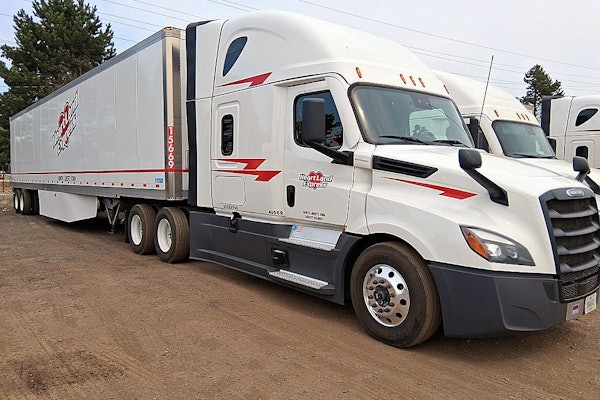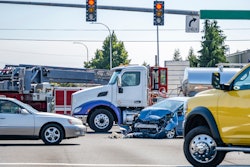The lack of available truck parking has ranked as the No. 2 concern in trucking for the second year in a row in 2024, according to the American Transportation Research Institute. It was the No. 1 issue among truck drivers.
The obvious solution is to just build more truck parking spaces, but that, of course, is easier said than done. Building additional parking requires land and money, both of which can be difficult to come by. There are ways fleets can help address this issue for their drivers.
Contents of this video
00:00 10-44 intro
00:18 Truck parking shortage
02:53 Truck parking availability information
04:11 Parking and hours of service
05:01 Improved driver performance
07:04 Helping drivers find parking
09:22 Lack of flexibility in the federal hours of service regulations
Matt Cole:
How the trucking industry is working to address the truck parking crisis.
Jason Cannon:
You're watching CCJ's 10-44, a weekly episode that brings you the latest trucking industry news and updates from the editors of CCJ. Don't forget to subscribe and hit the bell for notification so you'll never miss an installment of 10-44.
Hey everybody, welcome back. I'm Jason Cannon, and my cohost is Matt Cole. A lack of available truck parking has ranked as the number two concern for the trucking industry for the second year in a row in 2024. That's according to the American Transportation Research Institute. It was the number one issue among truck drivers.
Matt Cole:
The obvious solution is to just build more truck parking spaces, but that of course is easier said than done. Building additional parking requires land and money, both of which can be difficult to come by. There are a way fleets can help address this issue for their drivers, though
Adam Lang:
When you have, I guess you could say some larger companies, they might have the buying power to allow their drivers to reserve spots. That's one way to circumvent the lack of a trucking space is calling ahead and reserving a spot, and some companies have those resources, some don't. Coming off of a really tough economic year for trucking, I wouldn't be surprised if some maybe didn't spend as much on that because they're looking to save some costs. But I think there's so many different levels of how truck parking can contribute to a solid day's driving. The driver can relax, the driver can refuel, the driver feels safe, the driver's in a spot that they've got the right amenities, and they can then start out their day on the right foot. I hear a lot of times, and we specifically have rolled out a what's called roadside parking alert, which in essence, after a certain amount of time, creates an alert to the fleet manager, safety manager, whomever gets those alerts that the driver is on a highway parked for some reason, and after that amount of time lapses, then the driver manager, whomever, once they see that alert, they can reach out to the driver to make sure there's no problems, issues going on, need to be hooked up with road service and ensure that there's a legitimate reason why they're pulled over because we know what can happen if they're not pulled over for a valid reason, which happens from time to time.
But in any case, it creates some unsafe situations at the worst and at the best, not having a good parking spot will drain some funds based on productivity driver searching for an additional spot, reduced hours of service, potential risk of off-duty driving this classification. That can give you a log falsification on your CSA. I've heard all of these things being impacted.
Jason Cannon:
There's definitely a real truck parking problem in many areas across the country, but sometimes there's just a lack of truck parking availability information getting to truck drivers. Several states have installed roadside signs to let drivers know how many open spots there are at upcoming rest areas.
Adam Lang:
It's something where if I was driving down the road, let's say I had plenty of drive time, but I only have 45 minutes of on-duty time left before I have to take a break. Knowing that 30 to 40 minutes away there's an open parking spot would give me kind a sense of relief. Now, as an over the road driver, I'm probably going to do a lot of pre-planning and the best OTR drivers that I've ever talked to plan for contingency plan that if they can't make it here due to weather or other factors, they're going to go to this location and park. But the additional resource of rust areas I think is fantastic and it's a good first step to maybe create more spots and kind of a future blueprint on how this could be done, maybe even privately with truck stops mimicking the type of notification system that the DOT is, and there's probably some synchronicity there that they could exercise.
Matt Cole:
Adam says that while drivers do have some options within their hours of service to find a safe place to park at the end of their day, law enforcement may not always see it that way.
Adam Lang:
There's got to be more leniency with enforcement when it comes to this particular issue. The problem with that is that people can lie, and it's difficult sometimes because driver's best intentions might end up being something they didn't think of or an option of parking they didn't think of before. They used off-duty drive to boogie 10 miles down the road to park at another truck stop, and an officer might give 'em a falsification over that. So I feel like there's got to be some leniency involved in that as well, so that people aren't so cagey about using their options when they don't have a safe place to park.
Jason Cannon:
Now, the more fleets can do to help drivers when it comes to finding parking, the better their performance is going to be.
Adam Lang:
It's in the driver manager's best interest for the driver to be of the right mindset, have the right attitude and not stress about some of the small stuff. The more our mind can be on the job, the better we're going to be at it, the right kind of attitude we're going to have, and I feel like attitude drives performance. So if you're in a good state of mind, your abilities become more enhanced. If you're in a bad state of mind, you become distracted, you become upset, and you start suffering from something that I love. I heard this before, I don't know who coined this phrase, but stinking thinking drivers have a lot of time on the road to do that, and your thoughts can spiral to some pretty dark places, and all of that could stem from not knowing where I'm going to park that uncertainty.
People don't like that. So if you can lend more certainty to driver's day routine, it's going to keep them in a good frame of mind, which will contribute to safety. They'll be able to sleep better that evening. They're more likely to have a nutritious meal or a meal in general. If you're stressed out, sometimes you don't eat because that physiological response outweighs your hunger response. And then three hours later when you're not as stressed but you're feeling upset and angry, you might think, why am I so angry? Why am I mad about something? And all of a sudden realize, oh God, I'm hungry. So your emotions are kind of overriding some of your body's responses. That can be a bad thing. So to circle back to it, I feel like it's definitely top five things that a driver manager wants and needs to have in place to know where their drivers are going to park, logistically speaking, but also for the driver's state of mind and the driver's ability to perform their job.
Matt Cole:
Adam says there are a few ways fleet managers can help their drivers in finding parking.
Adam Lang:
Yeah, everybody has access to GPS systems and top-down map views, things like that, where a driver manager can do a little bit of reconnaissance in an area where the driver's going to be parked for that evening and say, okay, so here's your options. Especially with a newer driver that hasn't gone to a certain area. You're not talking to 20 year veteran that knows every little truck stop on every stretch of road. We're talking about a lot of newer drivers that might be considered experience at six months, and that's what the industry is evolved into. So the driver manager can be just a pure lifeline in terms of, okay, I'm researching this and let the driver drive and you do the heavy lifting and look at the maps to find out where this is. Now, also, you can use systems like Trucker Path or Truck Parking Club, which also rely heavily on crowdsource information and things like that.
So I feel like, I don't know how you'd do it, but creating more sensors to tell if parking spots are available, making sure that things like snow or weather doesn't confound the system, or like a motorist pulls into a truck parking area and a rest stop instead of an actual truck. So that takes away a whole spot that has to have some measure of enforcement there. Online reservations, the ability for a driver manager to say, Hey, I got a driver coming. They call the loves, the ta, the pilot wherever says, Hey, my driver's going to be there around this time. I want to reserve 'em a spot. I'm going to pay for it so they don't have to worry about it. Things like that really lift a burden off the driver. Hey, don't worry about it. I got a parking spot I'll set up for you. That's really concierge first rate service, and in my opinion, drivers deserve that. And driver managers that do those types of things for their drivers, they're going to have higher retention rates too, and higher satisfaction, which is win-win, win across the board, better safety, better economic efficiency, better use of dollars, happier people. I mean, I don't see where that loses at all.
Jason Cannon:
Adam says the lack of flexibility in the federal hours of service regulations when it comes to end of hours situations creates difficult situations for drivers and for fleets.
Adam Lang:
Well, they thought they did a little bit with the off-duty driving. The problem is they didn't enact any statutory language with off-duty driving like you cannot find it. You can only find off-duty. What they did do is released guidance, right? So they've got a couple of pages of guidance on scenarios where off-duty driving would be considered acceptable. But then you have how many thousands of enforcement officers, CMV inspectors, they could be highway patrol, they could be civilian inspectors, they could be Coney Sheriff or city police, depending on where they're at, and their training might all be slightly different, and people are people, they're going to interpret things a little bit differently. And when you get violations like falsification, that hits hard, that hits your CSA, even for larger companies, that's painful. You're going to see a change the next month, and let's say your driver was right and you followed the guidance, well, now you got to wait two to three months for the data queue process, right?
You're not given the benefit of the doubt. You're not presumed innocent with violations, you're presumed guilty, and you have to go through that data queue process to get it removed. And CSA is time-based man. So if you get another legitimate falsification on top of that illegitimate falsification, all of a sudden you could be edging up to that threshold or F-M-C-S-A sends you a note saying, Hey, you need to improve your hours of service. That's no win, because again, that's based on one person's interpretation of the rules of hours of service, and it's not fair in every circumstance, and they don't give the benefit of the doubt. Many times they just slap you with a violation.
Jason Cannon:
That's it for this week's 10-44. You can read more on ccjdigital.com. While you're there, sign up for our newsletter and stay up to date on the latest in trucking industry news and trends. If you have any questions or feedback, please let us know in the comments below. Don't forget to subscribe and hit the bell for notifications so you can catch us again next week.










